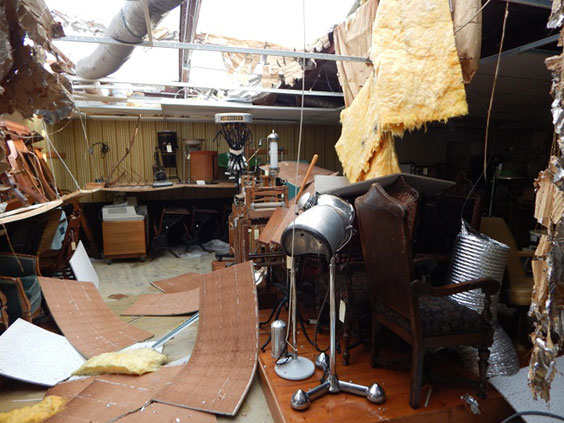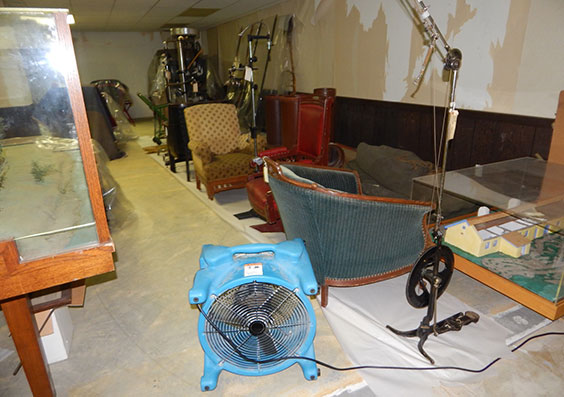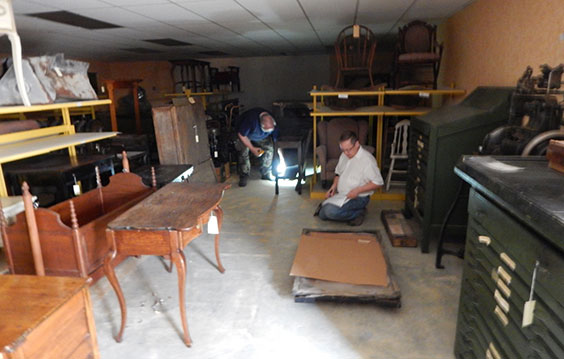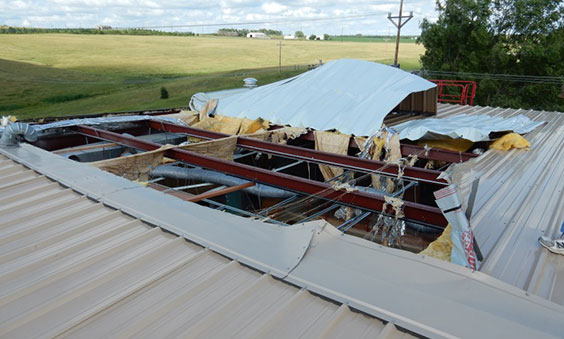Near the end of June 2018, a storm with strong winds and heavy rain rolled through Bismarck. State Historical Society security received an alarm in the middle of the night for an off-site storage facility. Our security supervisor initially did not see any damage, but he went back in the morning to discover a section of the roof had blown off the building. There was significant water damage to an artifact room on the second floor. He followed protocol and immediately notified the staff members identified in our agency’s Emergency Disaster Plan to respond.

Part of a roof was damaged during a summer storm at the State Historical Society’s off-site storage facility. Ceiling tiles and water fell on some artifacts and some duct work for the HVAC system was destroyed.
Within a short time, Museum Division staff traveled to the storage facility to assess the situation. First power had to be turned off, since lighting fixtures were down and electrical wiring was exposed to standing water. The room was checked to make sure nothing overhead could fall and harm staff. The next step was to remove debris and wet artifacts from the room. As each artifact was moved to a different part of the building, water was blotted from the artifacts. Items were placed on newsprint near fans to dry quickly in order to prevent mold growth and further damage. A few upholstered pieces were packed with newsprint to help absorb water. Squeegees helped to remove standing water on the floor. Wet ceiling tiles and insulation were removed and thrown away. There was not enough extra space to move all artifacts from the damaged room, so plastic sheeting was put up to protect the remaining artifacts.

Artifacts were placed on newsprint to dry. All of the crevices were packed with newsprint to draw out the moisture.

Staff members Len Thorson and Mark Halvorson inventoried the items being removed from the damaged room. Temporary locations were updated in the database for the displaced artifacts.
The damaged roof was salvageable as a temporary fix. It was secured until a new roof can replace it this fall. Administration staff arranged for a dumpster for debris and contacted insurance company adjusters, roofing contractors to examine the damage, and a heating and cooling company to check on a wet furnace and the destroyed ductwork. After it was deemed safe to do so, the electricity and some of the air handling units were turned on to help dry out the building.


Before and after photos of the hole in the roof and the temporary repair.
A few days later, there was another storm with high winds and heavy rain. The plastic sheeting wall protecting the artifacts came down, and more water entered the building through the partially repaired roof. Luckily, no additional artifacts were damaged. The water was cleaned up and all of the artifacts still in the room were covered with plastic sheeting to protect them from future incidents.
Due to the agency’s Emergency Disaster Plan, all employees, from security to museum collections to administration, knew their roles and what they needed to do in such a situation. We did our best to take care of the objects in harm’s way, but there is still more to do. Staff continue to assess artifacts and update necessary reports. The roof and building need further repairs, and objects need to be moved back into storage locations following repairs. We plan to complete the roof and inside repair work in the next few months and are hiring an intern to assist with an inventory of artifacts and new storage solutions. Thanks to an agency staff that understood how to quickly respond because of the plan in place, numerous artifacts were saved and a team came together to smoothly resolve a disaster situation.

